How To Draw A Phasor Diagram Using Excel
This tutorial will demonstrate how to create a polar plot in all versions of Excel: 2007, 2010, 2013, 2016, and 2019.
Polar Plot – Free Template Download
Download our free Polar Plot Template for Excel.
Download Now
A polar plot is used to ascertain a betoken in space within what is called the polar coordinate system, where rather than using the standard x- and y-coordinates, each point on a polar plane is expressed using these 2 values:
- Radius (r) – The altitude from the center of the plot
- Theta (θ) – The angle from a reference angle
The plane itself is made up of concentric circles expanding outward from the origin, or the pole—hence the name. The polar plot comes in handy when the analyzed data has a cyclical nature.
As an case, the chart below compares the customer satisfaction scores (CSAT), a metric that illustrates a customer's satisfaction with a make or product, of two organizations throughout 2019: Simpson Ltd and Griffin Ltd.
The plot enables yous to quickly assess the good and bad months for each company, which facilitates better conclusion making.
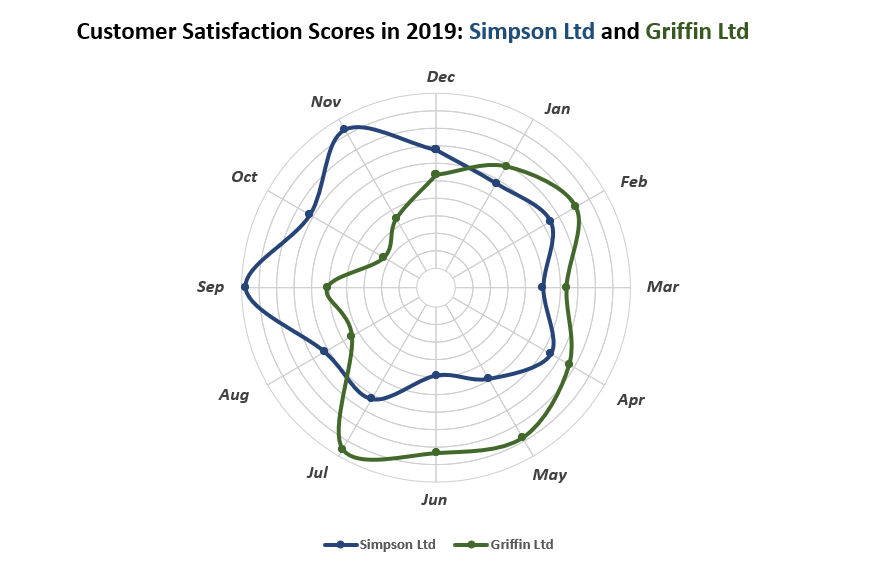
Nonetheless, hither's the rub:
Excel doesn't support this chart type—in fact, it can't fifty-fifty read polar coordinates—meaning you will have to build it from scratch. Likewise, don't forget to check out the Nautical chart Creator Add-In, a powerful tool for building heed-blowing advanced Excel charts and graphs in just a few clicks.
In this in-depth, pace-by-step tutorial, y'all will acquire how to turn your raw data into a polar plot in Excel from the basis up. For the record, this article is based on the tutorial created by Jon Peltier.
Getting started
Since CSAT scores are unremarkably expressed as a per centum scale, consider the following tabular array:
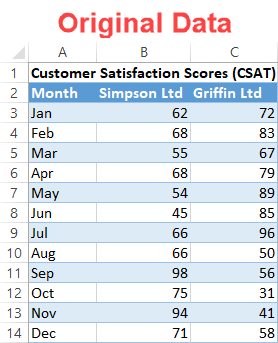
Stride #1: Set upwards a helper table.
Right off the bat, outline a helper table where all the calculations for your nautical chart will take place. To build the plot, you lot need to compute the polar coordinates kickoff and, once there, convert them to the x- and y-axis values used past Excel to create the chart.
Gear up up a separate dummy table as follows:
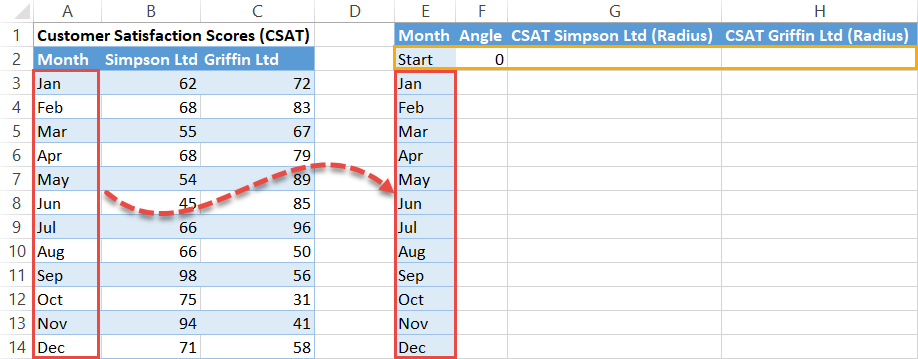
Notice how the helper table starts with a dummy row (E2:H2)—this determines the reference angle. Let's talk about each element of the table a bit more than in item:
- Calendar month – This column contains the qualitative categories derived from your original information. Type "Starting time" in the kickoff cell (E2) and re-create the categories (in our case, the months) correct beneath it (E3:E14).
- Bending (Theta) – This column contains the theta values responsible for drawing the spokes where the actual values will be placed. You should always blazon "0" into the get-go cell (F2) of this column.
- CSAT Simpson LTD (Radius) and CSAT Griffin LTD (Radius) – These columns incorporate the radius values illustrating the performance of each company throughout the year.
Step #ii: Compute the Bending (theta) values.
If you lot already have your r and theta values figured out, skip this part and ringlet down to Step #4.
In this pace, our aim is to evenly map out the spokes based on the number of categories in the dataset. As ane full circular rotation equals 360 degrees, to pull off the task, you have to divide 360 by the number of categories in your dataset (in our case, twelve months).
So, add together up that number every bit you go forth from zero to all the manner to 360. And that's where the COUNTA office comes into play. Basically, it counts the number of cells that are non empty within the specified range.
Copy this formula into cell F3:
=360/COUNTA($A$3:$A$14)
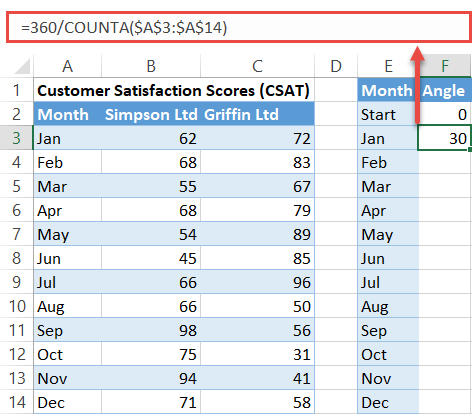
With that formula in cell F3, use this other formula in cell F4 to add together up a given Angle value to the sum of all the theta values that go before it in the cavalcade:
=F3+360/COUNTA($A$3:$A$14)
It is of import to lock the prison cell range (A3:A14) to easily copy the formula into the remaining cells.
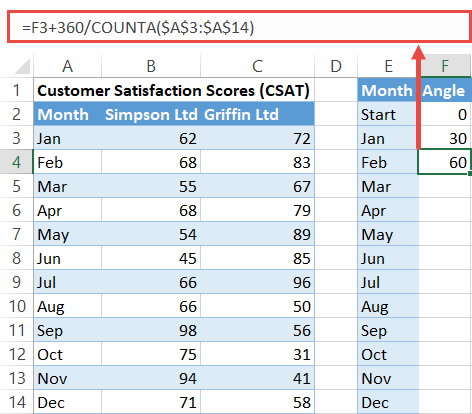
Now execute the formula for the rest of the cells in the column (F5:F14) by selecting F4 and dragging down the fill up handle.
Pace #iii: Compute the Radius values.
The polar plot volition exist fabricated up of x data rings, each radial bespeak (the distance between the inner and outer edge of a ring) representing a x percent increase on a scale from 0 to 100.
Since CSAT scores are also measured on the percent scale, but split up each CSAT score table by 10.
Here's how you do that quickly and hands. To find the Radius values for the first company (Simpson Ltd), enter this tiny formula into prison cell G3 and re-create it into the remaining cells (G4:G14):
=B3/10
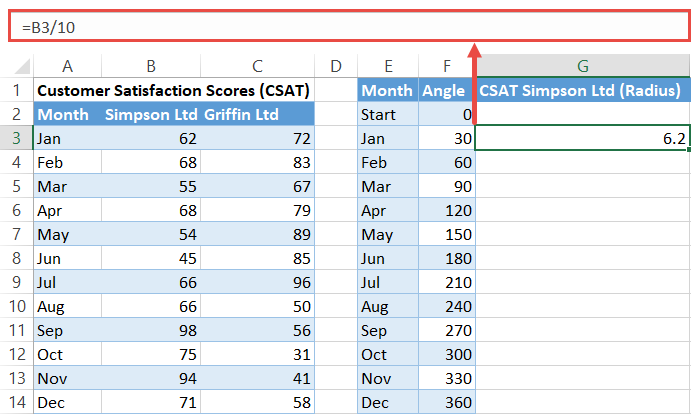
Now, by the same token, summate the radii for the second company (Griffin Ltd):
=C3/ten
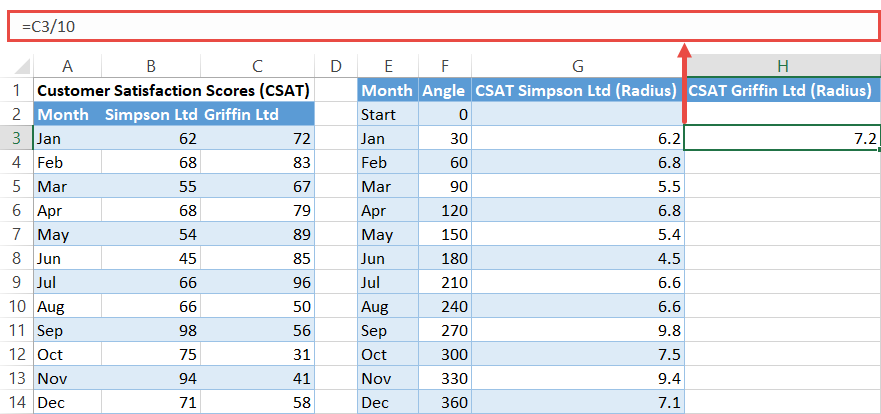
At this point, yous may be thinking to yourself, "What if my data blazon differs? How do you conform when comparing, for instance, the acquirement generated by companies equally opposed to CSAT scores?"
Simply put, you have to clarify your actual data, define the equivalent to one radial point (say $50,000), and separate all the values in your dataset by that number. Suppose some company generated $250,000 in May. To notice your radius, carve up $250,000 past 50,000. As elementary as that.
Step #four: Copy the last Radius values into the helper row.
Complete the tabular array by copying the r values at the very lesser (G14:H14) of each cavalcade into the corresponding dummy cells (G2:H2).
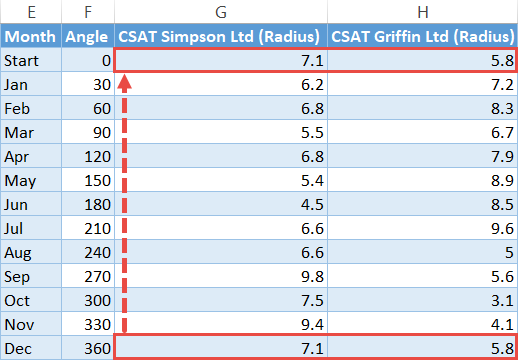
Pace #5: Summate the 10- and y-axis values for each visitor.
It's time to move on to turning the polar coordinates into the relevant x- and y-axis values. Thank you to trigonometry, you lot tin can make the transition happen by using the 2 special formulas yous are about to learn in a few seconds.
Allow's start with the 10-axis values first. In the cell adjacent to the helper table (I2), enter the post-obit formula:
=G2*SIN(F2/180*PI())
Copy this formula into the remaining cells below it (I3:I14).
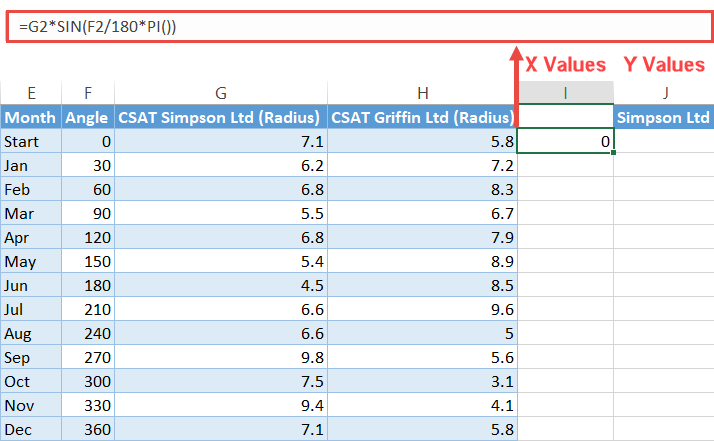
In just the same way, plug this formula into cell J2 to find the y-axis values and execute it for the rest of the cells (J3:J14) besides:
=G2*COS(F2/180*PI())
Of import note: Keep in mind that the header row jail cell (J1) of a cavalcade with y-axis values (column J) will act as the series name, meaning the value in that cell will go to the chart fable.
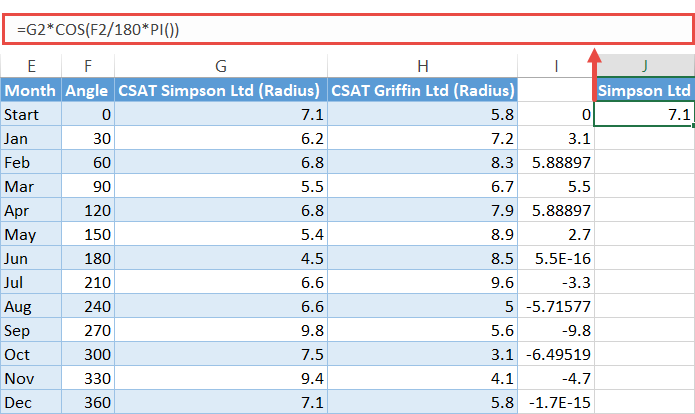
Repeat the verbal aforementioned process to compute the 10 and Y values for the second company, adjusting the formula to apply the data in the Griffin Ltd column:
=H2*SIN(F2/180*PI())
=H2*COS(F2/180*PI())
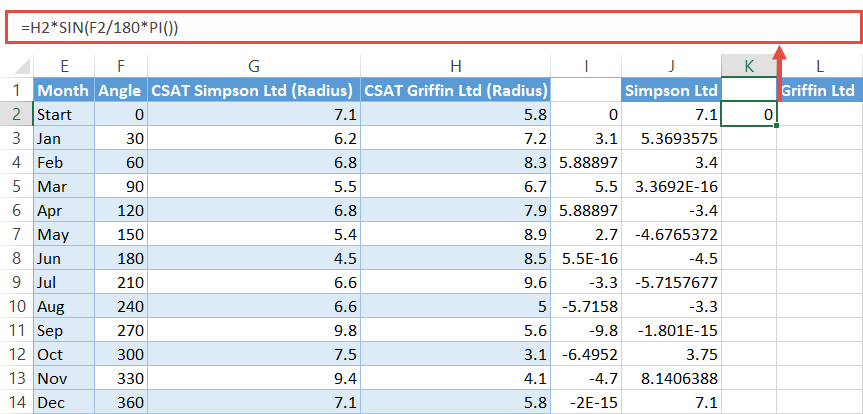
Step #6: Set the second helper table for the polar plot grid.
Yeah, you heard it right. You need yet another helper table. Fortunately, the worst is behind u.s. every bit it won't take a single formula to put the table together.
Take a quick await at it:

Essentially, the table is comprised of 3 elements:
- The qualitative scale (the yellow surface area or N2:N11) – This reflects the value intervals based on your actual data. Fill in the cells with percentages as shown in the screenshot. As an instance of alternate information, if we were to analyze the acquirement mentioned before, this cavalcade would become from $50,000 to $500,000.
- The header row (the red area or O1:Z1) – This contains all the category names derived from the original data table, but placed vertically.
- The filigree values (the dark-green surface area or O2:Z11) – These values volition split the hereafter data rings into equal parts, outlining the plot grid. But selection a number out of sparse air and re-create it into all the cells inside the range.
Step #seven: Create a set up of doughnut charts.
At last, you have gathered all the necessary chart data—that was pretty intense. Wave goodbye to functions and formulas because y'all tin can now kickoff building the polar plot itself.
Beginning with setting up the polar aeroplane by creating x doughnut charts stacked on top of each other:
- Highlight all the grid values from the 2nd helper table (O2:Z11).
- Go to the Insert tab.
- Click the "Insert Pie or Doughnut Chart" button.
- Cull "Doughnut."
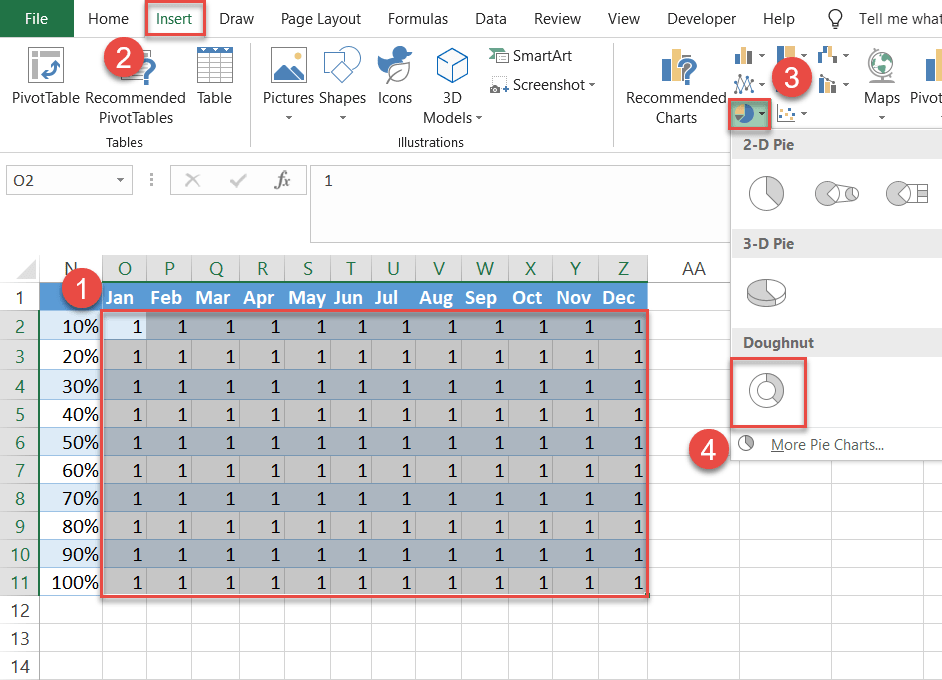
Excel should give you a set of 10 rings as a consequence.
Sometimes Excel fails to read your data the right way. To work around the effect if this happens to y'all, follow a few straightforward instructions to stack your charts manually. For illustration purposes, let'due south assume you set out to analyze the data for eight months instead.
First, select whatever empty prison cell and build an empty doughnut chart past following the steps outlined higher up.
Then, correct-click on the chart plot and cull "Select Information."
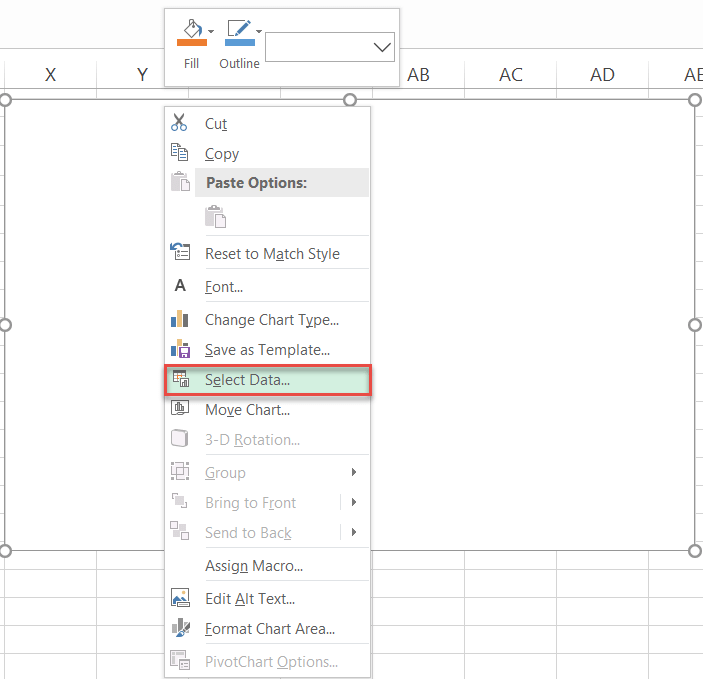
Subsequently that, in the Select Data Source dialog box, click the "Add" button.
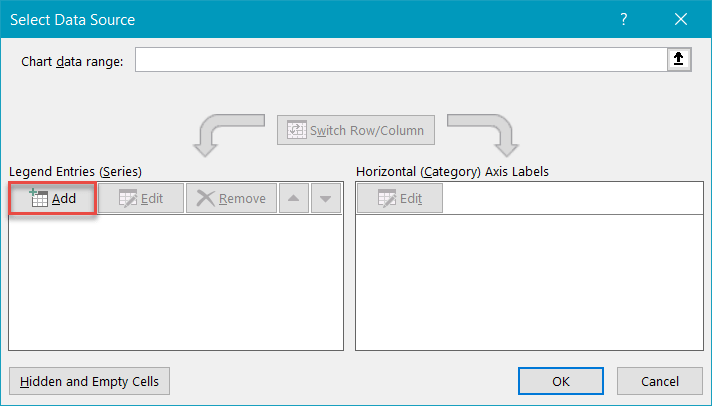
In the Edit Series box, select all the filigree values in the first row (O2:V2) and click "OK."
As you may take guessed it, rinse and repeat for each row to get the same 10 rings plotted on the chart.
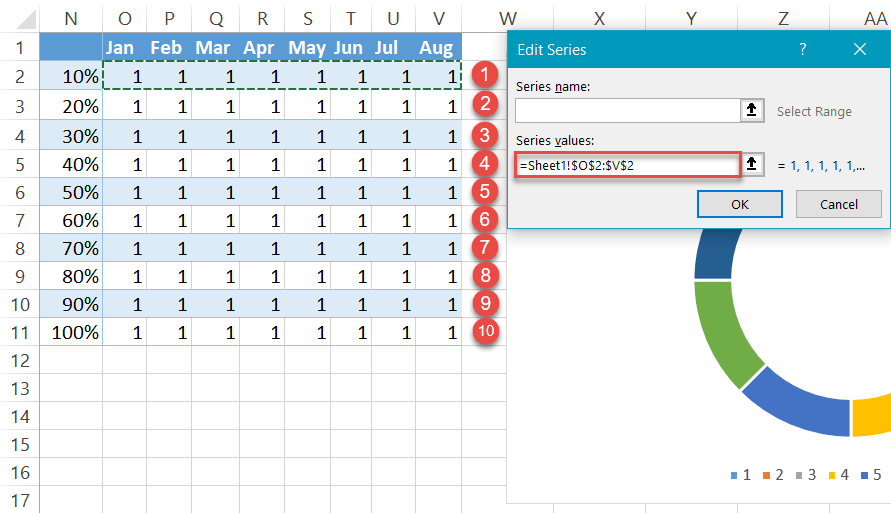
Step #8: Reduce the Doughnut Pigsty size.
Every bit you see, all the rings have been squeezed together abroad from the heart. Permit's change that by reducing the Doughnut Hole size.
- Right-click any data ring.
- Select "Format Data Serial."
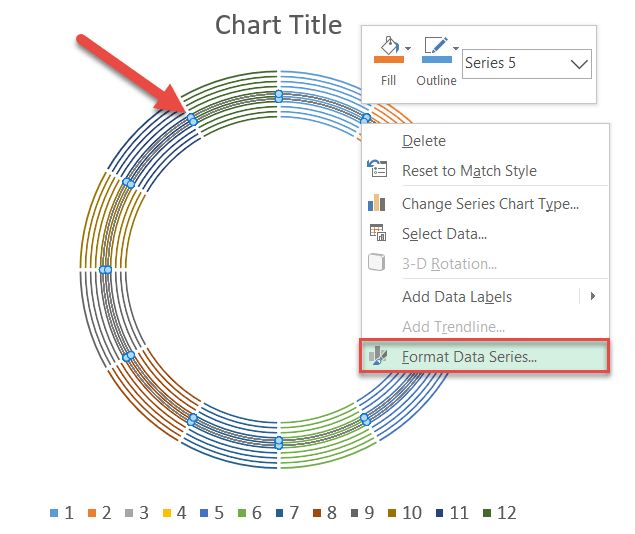
In the task pane that pops up, change the default Doughnut Hole Size value to make magic happen:
- Switch to the Series Options tab.
- Set up the Doughnut Hole Size to "x%."
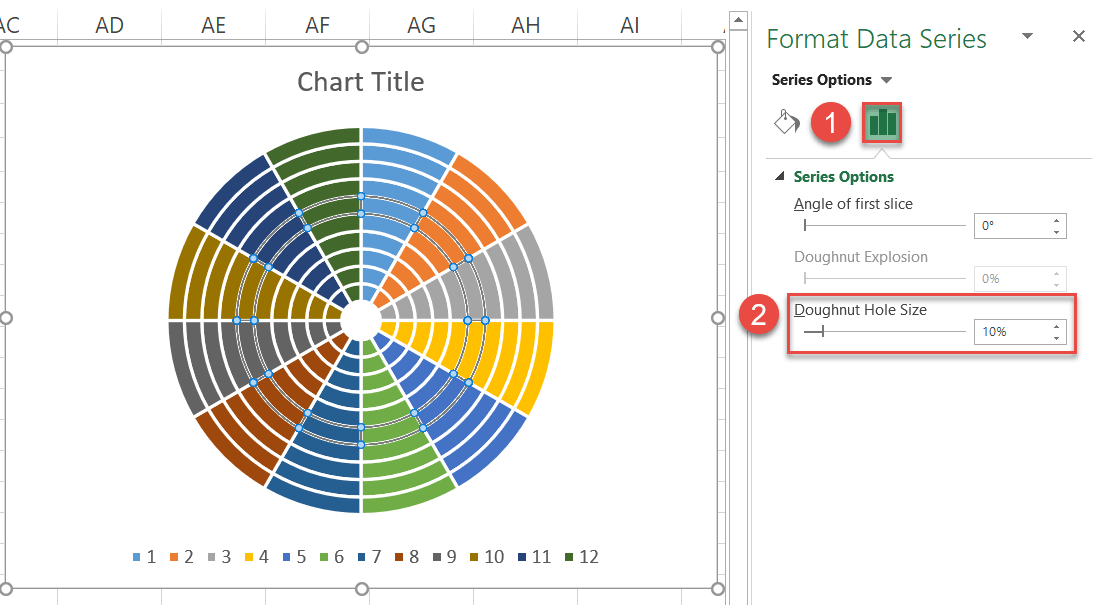
Stride #nine: Set up the chart grid.
In the same job pane, transform the rings into a grid by following these simple steps:
- Go to the Make full & Line tab.
- Nether "Fill," cull "No fill up."
- Under "Border," select "Solid line."
- Click the "Outline colour" icon to open the color palette and select light gray.
- Prepare the Width to "5 pt."
Rinse and repeat for the rest of the rings.
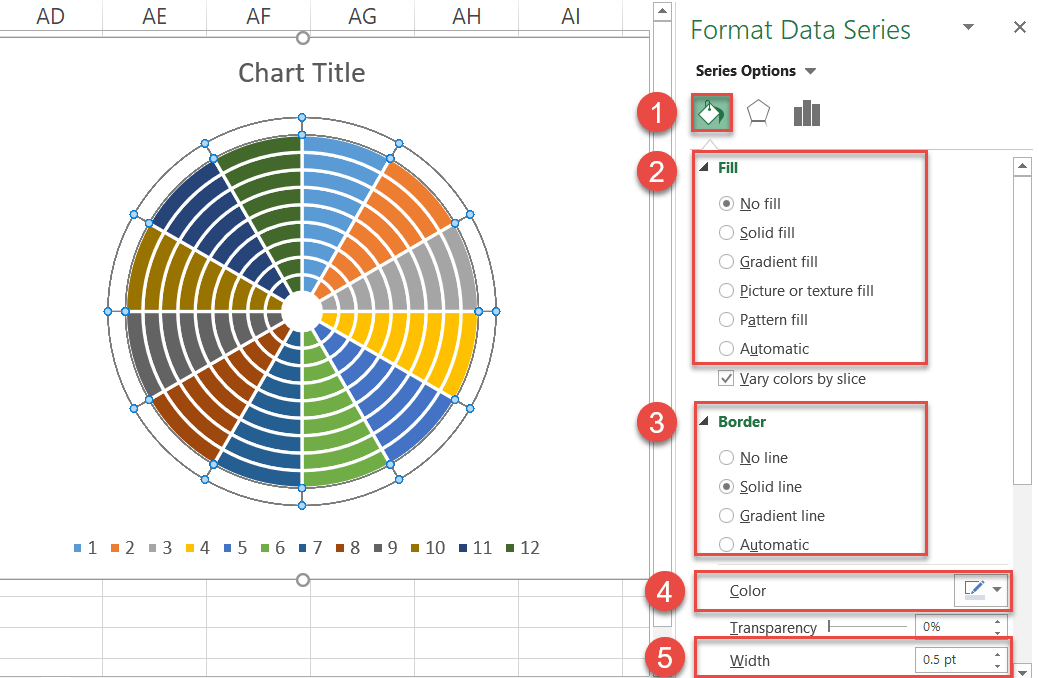
Stride #10: Add the chart data.
At present that the background has been laid, add together the x and y values from the outset helper table to the chart.
- Highlight all the ten- and y-axis values illustrating the CSAT scores of the first visitor (Simpson Ltd) as well as the header row cells (I1:J14) and copy the data (right click and select Copy).
- Select the chart area.
- Navigate to the Abode tab.
- Click the "Paste" button.
- Choose "Paste Special."
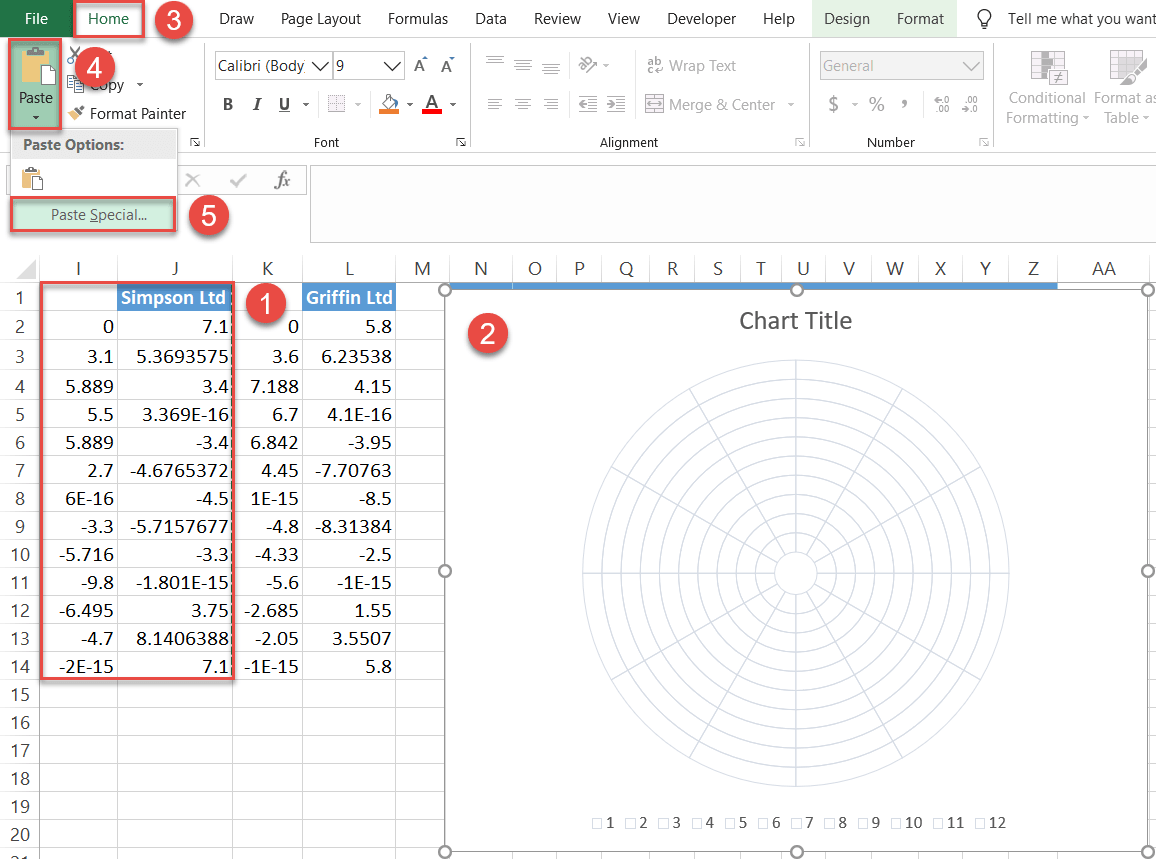
In the tiny Paste Special dialog box that appears, practice the following:
- Nether "Add cells as," choose "New serial."
- Under "Values (Y) in," select "Columns."
- Check the "Series Names in First Row" and "Categories (X Labels) in First Column" boxes.
- Click "OK."
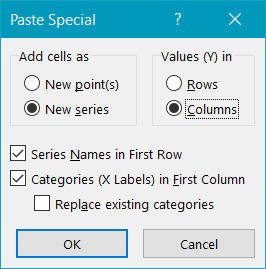
Repeat the procedure to add the chart data linked to the second company (Griffin Ltd).
Step #11: Change the chart type for the inserted data series.
Now, alter the chart type of both the newly-added series representing the bodily values.
- Right-click on either of the series representing the actual values (either Series "Simpson Ltd" or Serial "Griffin Ltd").
- Choose "Change Series Chart Blazon."
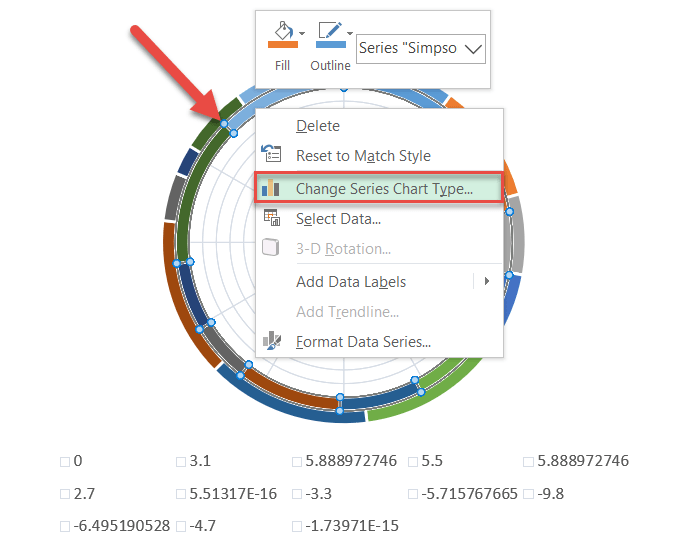
Once at that place, modify the chart type for Series "Simpson Ltd" and Series "Griffin Ltd" to "Scatter with Polish Lines and Markers."
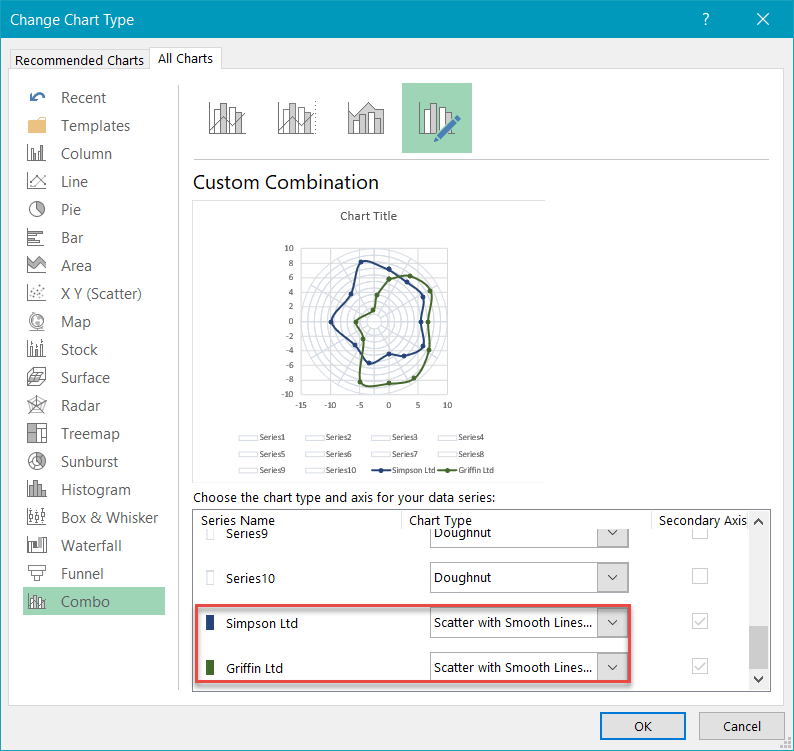
Step #12: Change the horizontal and vertical axis scales.
Once the chart axes popular up, modify both the horizontal and vertical axis scale ranges for the chart to accurately reflect the data plotted on it.
- Correct-click on the vertical centrality.
- Choose "Format Axis."
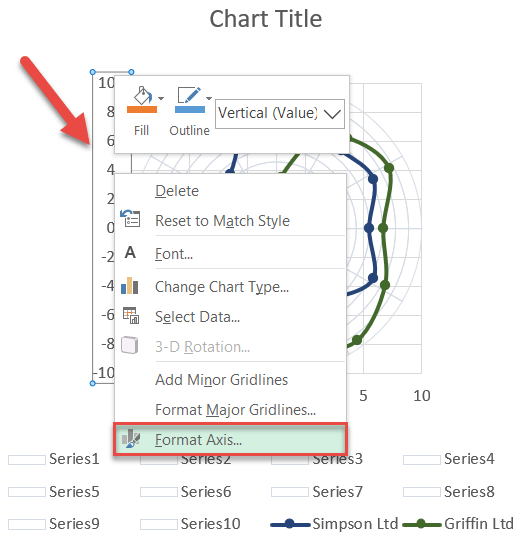
Once the task pane appears, define the new axis scale ranges:
- Go to the Axis Options tab.
- Fix the Minimum Bounds value to "-10."
- Change the Maximum Bounds value to "x."
After that, jump to the horizontal axis and do the exact same thing.
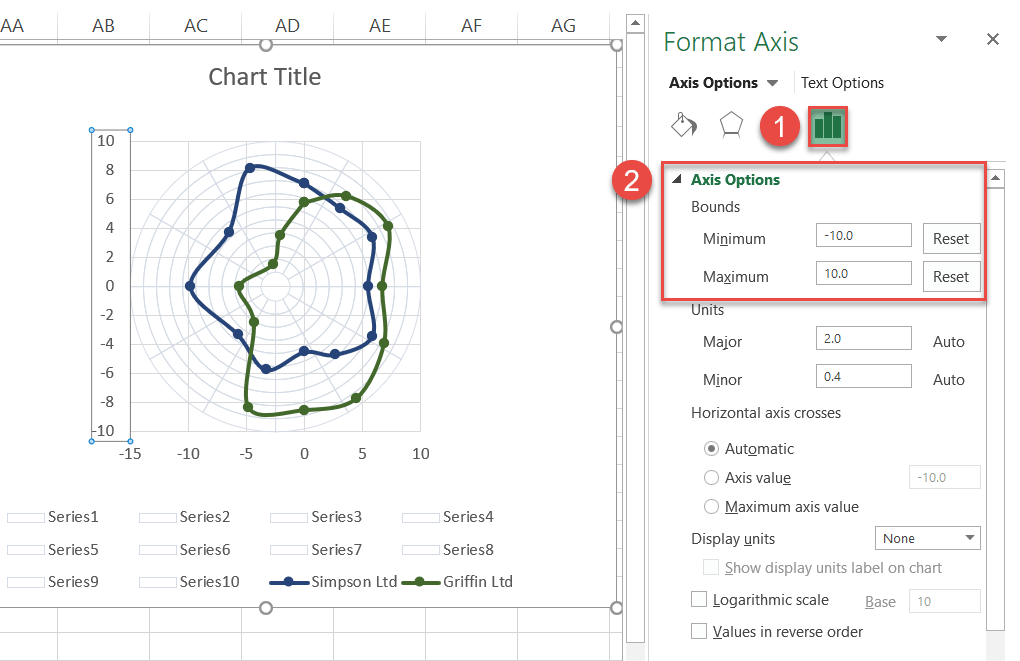
Step #xiii: Remove the gridlines, the axes, and the irrelevant legend items.
Clean up the plot past removing the chart elements that have no applied value whatsoever: the gridlines, the axes, as well every bit all the legend items—save for the ii that you actually need (mark the company information).
To exercise that, double-click on each element, then right-click on information technology once again, and choose "Delete."
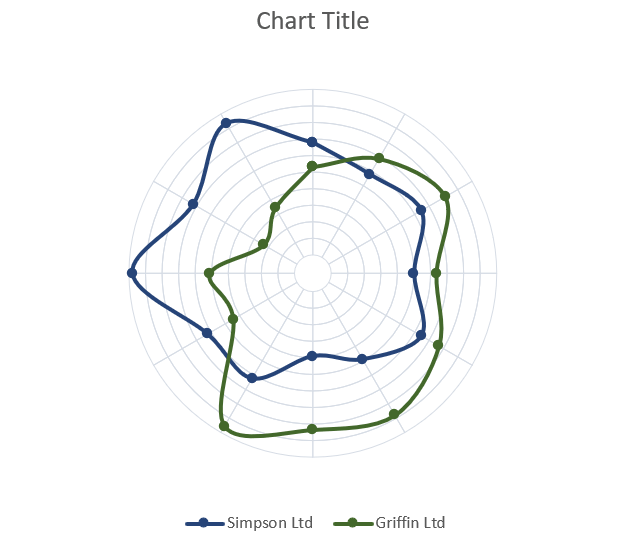
Step #14: Add together data labels.
As we gradually movement toward the end of our grand Excel run a risk, it's time to add the data labels representing each qualitative category in your dataset.
Right-click on the outer ring (Series "10") and choose "Add Data Labels."
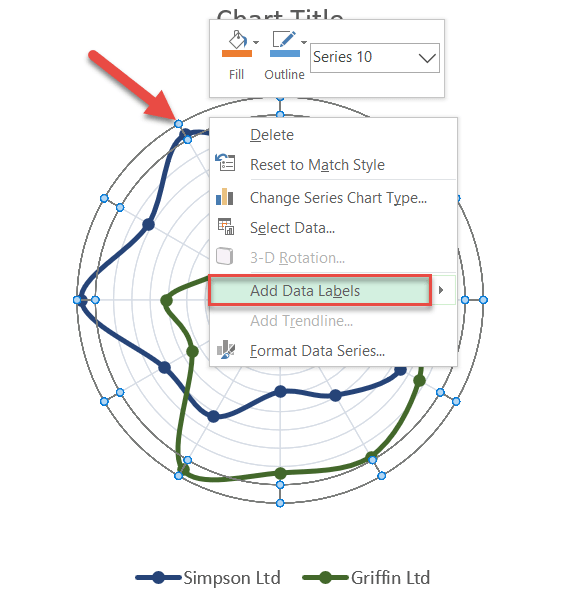
Step #15: Customize data labels.
Basically, all you need to do here is replace the default data labels with the category names from the table containing your actual information.
Right-click on any data label and select "Format Data Labels."
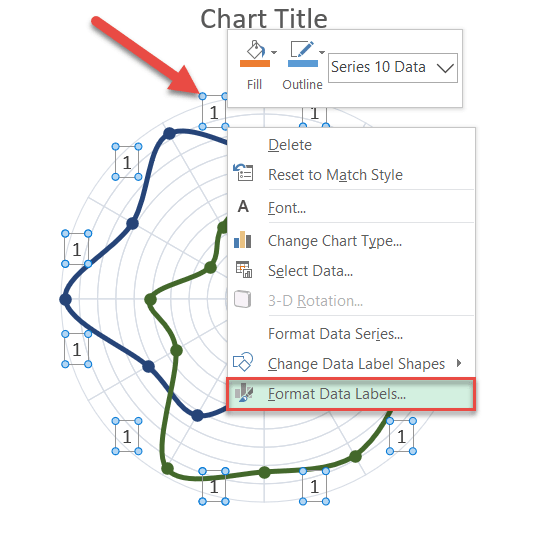
When the task pane opens, supervene upon the values by doing the following:
- Go to the Label Options tab.
- Check the "Value From Cells" box.
- Highlight the category values from your original data table (A3:A14).
- Click "OK."
- Uncheck the "Value" box.
- Uncheck the "Show Leader Lines" box.
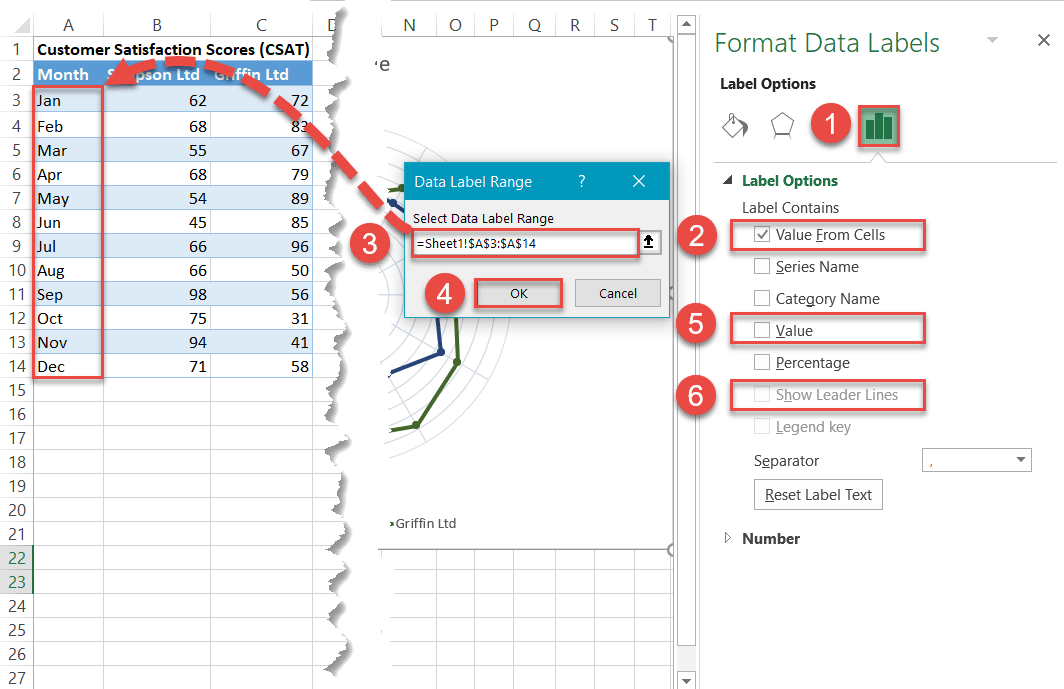
Step #16: Reposition the labels.
At present, shift the labels around a bit by placing them along the rim of the outer ring in the social club shown on the screenshot beneath. This will accept to exist done manually by dragging each title to the proper position.
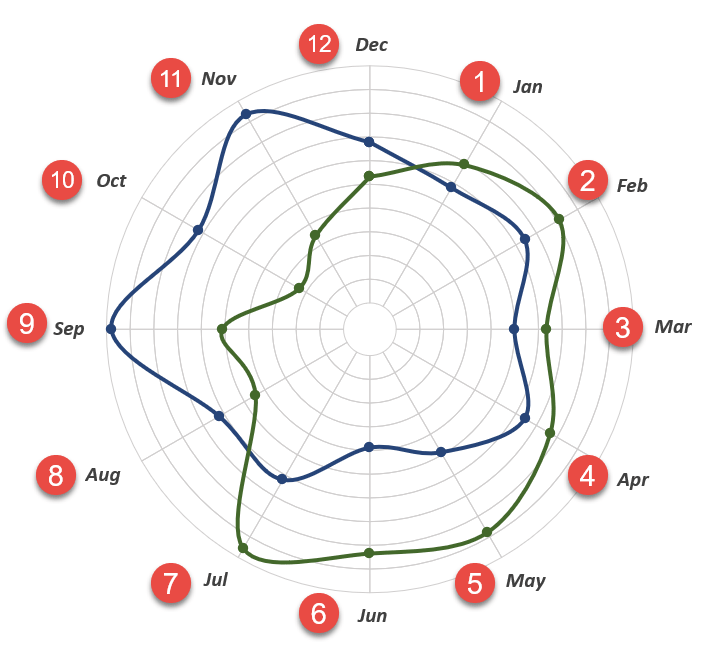
Finally, change the chart title, and you lot're all ready!

Download Polar Plot Template
Download our gratuitous Polar Plot Template for Excel.
Download Now
Source: https://www.automateexcel.com/charts/polar-template/
Posted by: troupeingthe.blogspot.com


0 Response to "How To Draw A Phasor Diagram Using Excel"
Post a Comment